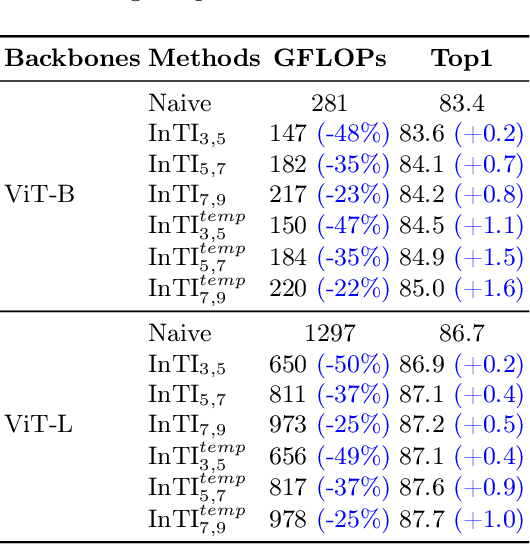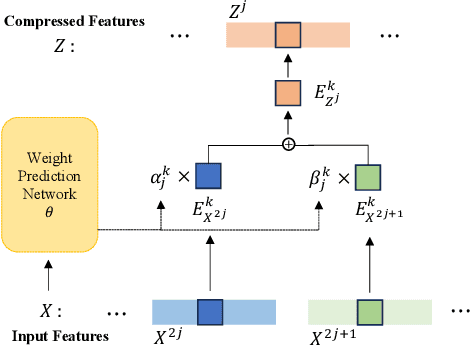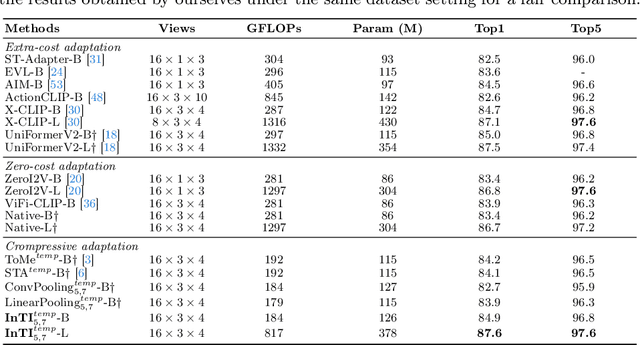Guozhen Zhang
Pack and Force Your Memory: Long-form and Consistent Video Generation
Oct 02, 2025Abstract:Long-form video generation presents a dual challenge: models must capture long-range dependencies while preventing the error accumulation inherent in autoregressive decoding. To address these challenges, we make two contributions. First, for dynamic context modeling, we propose MemoryPack, a learnable context-retrieval mechanism that leverages both textual and image information as global guidance to jointly model short- and long-term dependencies, achieving minute-level temporal consistency. This design scales gracefully with video length, preserves computational efficiency, and maintains linear complexity. Second, to mitigate error accumulation, we introduce Direct Forcing, an efficient single-step approximating strategy that improves training-inference alignment and thereby curtails error propagation during inference. Together, MemoryPack and Direct Forcing substantially enhance the context consistency and reliability of long-form video generation, advancing the practical usability of autoregressive video models.
Arbitrary Generative Video Interpolation
Oct 01, 2025Abstract:Video frame interpolation (VFI), which generates intermediate frames from given start and end frames, has become a fundamental function in video generation applications. However, existing generative VFI methods are constrained to synthesize a fixed number of intermediate frames, lacking the flexibility to adjust generated frame rates or total sequence duration. In this work, we present ArbInterp, a novel generative VFI framework that enables efficient interpolation at any timestamp and of any length. Specifically, to support interpolation at any timestamp, we propose the Timestamp-aware Rotary Position Embedding (TaRoPE), which modulates positions in temporal RoPE to align generated frames with target normalized timestamps. This design enables fine-grained control over frame timestamps, addressing the inflexibility of fixed-position paradigms in prior work. For any-length interpolation, we decompose long-sequence generation into segment-wise frame synthesis. We further design a novel appearance-motion decoupled conditioning strategy: it leverages prior segment endpoints to enforce appearance consistency and temporal semantics to maintain motion coherence, ensuring seamless spatiotemporal transitions across segments. Experimentally, we build comprehensive benchmarks for multi-scale frame interpolation (2x to 32x) to assess generalizability across arbitrary interpolation factors. Results show that ArbInterp outperforms prior methods across all scenarios with higher fidelity and more seamless spatiotemporal continuity. Project website: https://mcg-nju.github.io/ArbInterp-Web/.
UniCO: Towards a Unified Model for Combinatorial Optimization Problems
May 07, 2025Abstract:Combinatorial Optimization (CO) encompasses a wide range of problems that arise in many real-world scenarios. While significant progress has been made in developing learning-based methods for specialized CO problems, a unified model with a single architecture and parameter set for diverse CO problems remains elusive. Such a model would offer substantial advantages in terms of efficiency and convenience. In this paper, we introduce UniCO, a unified model for solving various CO problems. Inspired by the success of next-token prediction, we frame each problem-solving process as a Markov Decision Process (MDP), tokenize the corresponding sequential trajectory data, and train the model using a transformer backbone. To reduce token length in the trajectory data, we propose a CO-prefix design that aggregates static problem features. To address the heterogeneity of state and action tokens within the MDP, we employ a two-stage self-supervised learning approach. In this approach, a dynamic prediction model is first trained and then serves as a pre-trained model for subsequent policy generation. Experiments across 10 CO problems showcase the versatility of UniCO, emphasizing its ability to generalize to new, unseen problems with minimal fine-tuning, achieving even few-shot or zero-shot performance. Our framework offers a valuable complement to existing neural CO methods that focus on optimizing performance for individual problems.
UrbanPlanBench: A Comprehensive Urban Planning Benchmark for Evaluating Large Language Models
Apr 23, 2025Abstract:The advent of Large Language Models (LLMs) holds promise for revolutionizing various fields traditionally dominated by human expertise. Urban planning, a professional discipline that fundamentally shapes our daily surroundings, is one such field heavily relying on multifaceted domain knowledge and experience of human experts. The extent to which LLMs can assist human practitioners in urban planning remains largely unexplored. In this paper, we introduce a comprehensive benchmark, UrbanPlanBench, tailored to evaluate the efficacy of LLMs in urban planning, which encompasses fundamental principles, professional knowledge, and management and regulations, aligning closely with the qualifications expected of human planners. Through extensive evaluation, we reveal a significant imbalance in the acquisition of planning knowledge among LLMs, with even the most proficient models falling short of meeting professional standards. For instance, we observe that 70% of LLMs achieve subpar performance in understanding planning regulations compared to other aspects. Besides the benchmark, we present the largest-ever supervised fine-tuning (SFT) dataset, UrbanPlanText, comprising over 30,000 instruction pairs sourced from urban planning exams and textbooks. Our findings demonstrate that fine-tuned models exhibit enhanced performance in memorization tests and comprehension of urban planning knowledge, while there exists significant room for improvement, particularly in tasks requiring domain-specific terminology and reasoning. By making our benchmark, dataset, and associated evaluation and fine-tuning toolsets publicly available at https://github.com/tsinghua-fib-lab/PlanBench, we aim to catalyze the integration of LLMs into practical urban planning, fostering a symbiotic collaboration between human expertise and machine intelligence.
Motion-Aware Generative Frame Interpolation
Jan 07, 2025Abstract:Generative frame interpolation, empowered by large-scale pre-trained video generation models, has demonstrated remarkable advantages in complex scenes. However, existing methods heavily rely on the generative model to independently infer the correspondences between input frames, an ability that is inadequately developed during pre-training. In this work, we propose a novel framework, termed Motion-aware Generative frame interpolation (MoG), to significantly enhance the model's motion awareness by integrating explicit motion guidance. Specifically we investigate two key questions: what can serve as an effective motion guidance, and how we can seamlessly embed this guidance into the generative model. For the first question, we reveal that the intermediate flow from flow-based interpolation models could efficiently provide task-oriented motion guidance. Regarding the second, we first obtain guidance-based representations of intermediate frames by warping input frames' representations using guidance, and then integrate them into the model at both latent and feature levels. To demonstrate the versatility of our method, we train MoG on both real-world and animation datasets. Comprehensive evaluations show that our MoG significantly outperforms the existing methods in both domains, achieving superior video quality and improved fidelity.
Dynamic and Compressive Adaptation of Transformers From Images to Videos
Aug 14, 2024



Abstract:Recently, the remarkable success of pre-trained Vision Transformers (ViTs) from image-text matching has sparked an interest in image-to-video adaptation. However, most current approaches retain the full forward pass for each frame, leading to a high computation overhead for processing entire videos. In this paper, we present InTI, a novel approach for compressive image-to-video adaptation using dynamic Inter-frame Token Interpolation. InTI aims to softly preserve the informative tokens without disrupting their coherent spatiotemporal structure. Specifically, each token pair at identical positions within neighbor frames is linearly aggregated into a new token, where the aggregation weights are generated by a multi-scale context-aware network. In this way, the information of neighbor frames can be adaptively compressed in a point-by-point manner, thereby effectively reducing the number of processed frames by half each time. Importantly, InTI can be seamlessly integrated with existing adaptation methods, achieving strong performance without extra-complex design. On Kinetics-400, InTI reaches a top-1 accuracy of 87.1 with a remarkable 37.5% reduction in GFLOPs compared to naive adaptation. When combined with additional temporal modules, InTI achieves a top-1 accuracy of 87.6 with a 37% reduction in GFLOPs. Similar conclusions have been verified in other common datasets.
Efficient Test-Time Prompt Tuning for Vision-Language Models
Aug 11, 2024



Abstract:Vision-language models have showcased impressive zero-shot classification capabilities when equipped with suitable text prompts. Previous studies have shown the effectiveness of test-time prompt tuning; however, these methods typically require per-image prompt adaptation during inference, which incurs high computational budgets and limits scalability and practical deployment. To overcome this issue, we introduce Self-TPT, a novel framework leveraging Self-supervised learning for efficient Test-time Prompt Tuning. The key aspect of Self-TPT is that it turns to efficient predefined class adaptation via self-supervised learning, thus avoiding computation-heavy per-image adaptation at inference. Self-TPT begins by co-training the self-supervised and the classification task using source data, then applies the self-supervised task exclusively for test-time new class adaptation. Specifically, we propose Contrastive Prompt Learning (CPT) as the key task for self-supervision. CPT is designed to minimize the intra-class distances while enhancing inter-class distinguishability via contrastive learning. Furthermore, empirical evidence suggests that CPT could closely mimic back-propagated gradients of the classification task, offering a plausible explanation for its effectiveness. Motivated by this finding, we further introduce a gradient matching loss to explicitly enhance the gradient similarity. We evaluated Self-TPT across three challenging zero-shot benchmarks. The results consistently demonstrate that Self-TPT not only significantly reduces inference costs but also achieves state-of-the-art performance, effectively balancing the efficiency-efficacy trade-off.
VFIMamba: Video Frame Interpolation with State Space Models
Jul 02, 2024Abstract:Inter-frame modeling is pivotal in generating intermediate frames for video frame interpolation (VFI). Current approaches predominantly rely on convolution or attention-based models, which often either lack sufficient receptive fields or entail significant computational overheads. Recently, Selective State Space Models (S6) have emerged, tailored specifically for long sequence modeling, offering both linear complexity and data-dependent modeling capabilities. In this paper, we propose VFIMamba, a novel frame interpolation method for efficient and dynamic inter-frame modeling by harnessing the S6 model. Our approach introduces the Mixed-SSM Block (MSB), which initially rearranges tokens from adjacent frames in an interleaved fashion and subsequently applies multi-directional S6 modeling. This design facilitates the efficient transmission of information across frames while upholding linear complexity. Furthermore, we introduce a novel curriculum learning strategy that progressively cultivates proficiency in modeling inter-frame dynamics across varying motion magnitudes, fully unleashing the potential of the S6 model. Experimental findings showcase that our method attains state-of-the-art performance across diverse benchmarks, particularly excelling in high-resolution scenarios. In particular, on the X-TEST dataset, VFIMamba demonstrates a noteworthy improvement of 0.80 dB for 4K frames and 0.96 dB for 2K frames.
Sparse Global Matching for Video Frame Interpolation with Large Motion
Apr 15, 2024



Abstract:Large motion poses a critical challenge in Video Frame Interpolation (VFI) task. Existing methods are often constrained by limited receptive fields, resulting in sub-optimal performance when handling scenarios with large motion. In this paper, we introduce a new pipeline for VFI, which can effectively integrate global-level information to alleviate issues associated with large motion. Specifically, we first estimate a pair of initial intermediate flows using a high-resolution feature map for extracting local details. Then, we incorporate a sparse global matching branch to compensate for flow estimation, which consists of identifying flaws in initial flows and generating sparse flow compensation with a global receptive field. Finally, we adaptively merge the initial flow estimation with global flow compensation, yielding a more accurate intermediate flow. To evaluate the effectiveness of our method in handling large motion, we carefully curate a more challenging subset from commonly used benchmarks. Our method demonstrates the state-of-the-art performance on these VFI subsets with large motion.
Dual DETRs for Multi-Label Temporal Action Detection
Mar 31, 2024Abstract:Temporal Action Detection (TAD) aims to identify the action boundaries and the corresponding category within untrimmed videos. Inspired by the success of DETR in object detection, several methods have adapted the query-based framework to the TAD task. However, these approaches primarily followed DETR to predict actions at the instance level (i.e., identify each action by its center point), leading to sub-optimal boundary localization. To address this issue, we propose a new Dual-level query-based TAD framework, namely DualDETR, to detect actions from both instance-level and boundary-level. Decoding at different levels requires semantics of different granularity, therefore we introduce a two-branch decoding structure. This structure builds distinctive decoding processes for different levels, facilitating explicit capture of temporal cues and semantics at each level. On top of the two-branch design, we present a joint query initialization strategy to align queries from both levels. Specifically, we leverage encoder proposals to match queries from each level in a one-to-one manner. Then, the matched queries are initialized using position and content prior from the matched action proposal. The aligned dual-level queries can refine the matched proposal with complementary cues during subsequent decoding. We evaluate DualDETR on three challenging multi-label TAD benchmarks. The experimental results demonstrate the superior performance of DualDETR to the existing state-of-the-art methods, achieving a substantial improvement under det-mAP and delivering impressive results under seg-mAP.
 Add to Chrome
Add to Chrome Add to Firefox
Add to Firefox Add to Edge
Add to Edge